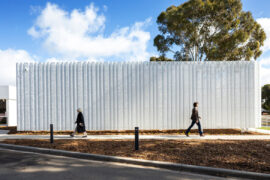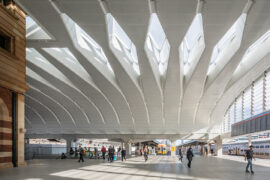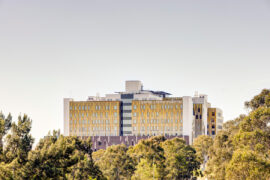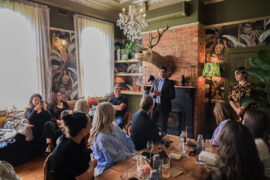A collaboration between Kosloff Architecture, Callum Morton and Monash Art Projects sees a modernist building reskinned with a contemporary façade.
Monash University was founded in 1958 to meet the demands of the post-war boom that required more graduates in science and technology. With the Clayton campus established and built from the ground up in the late-1950s and 1960s, the architecture was predominantly modernist, including the eight-storey Science South Building & Medical School extension, designed by Stephenson & Turner, built in 1969. Arthur Stephenson and Donald Turner had helped pioneer the modernist movement in Australian architecture, but half a century on, the building had seen better days.
Monash University engaged Kosloff Architecture in collaboration with artist Callum Morton and Monash Art Projects (MAP) to update and upgrade the building. The project included a new façade to significantly improve environmental performance; upgraded building services to future proof the facility and enable future installation of laboratories, offices, classrooms and lecture theatres; and a new entry foyer and building address.
“The project embraces our responsibility to adapt existing building stock and in doing so addresses the question of what it means to re-skin an existing 1960s modernist building in a contemporary manner,” says Julian Kosloff, director of Kosloff Architecture. “It was also tremendous opportunity to contribute to Monash University’s Public Arts Strategy by producing a building of shared authorship by architect and artist.”
The new façade of the building is a nod to the modernist cell and curtain wall, as well as to Callum’s sculptural work. Providing a lightweight cladding solution, modular glass-fibre reinforced concrete shells are attached SIPs panels that cover the original brick façade, with new services externalised within the white pods. Every vertical line has a slightly different three-dimensionality, which creates a graphic, wave-like effect that stretches and compresses over the entrance.
“When you view in elevation, it appears modernist. Static and ordered. When you view from the corner, the façade has a contemporary reading that is dynamic and fluid, negotiating the entry as a drape hung from above,” Julian says. This draped effect can also be seen in Callum’s installation and sculptural practice. In his 2014 exhibition Neighbourhood Watch, Callum created five sculptural works of nineteenth-century Melbourne monuments that appeared veiled in plastic.
Where the drape lifts at the bottom of the building, the original brick can be glimpsed either side of the entrance – a bright orange trumpet-like portal that funnels people inside. Artworks from Monash University’s extensive collection are on display in the gallery space in the foyer and entrance. The building houses the biology and psychology faculties including a lecture theatre, classrooms, laboratories, offices and administration facilities, all of which remained in use throughout the construction process.
“The built outcome is a seamless integration of Kosloff Architecture, Callum Morton and MAP,” says Julian. “The building is neither wholly new, nor a faithful restoration of the original, but something else altogether.”
–
Get more design inspiration, sign up for our newsletter. Or check out other projects by Kosloff Architecture.
INDESIGN is on instagram
Follow @indesignlive
A searchable and comprehensive guide for specifying leading products and their suppliers
Keep up to date with the latest and greatest from our industry BFF's!
The new range features slabs with warm, earthy palettes that lend a sense of organic luxury to every space.

Rising above the new Sydney Metro Gadigal Station on Pitt Street, Investa’s Parkline Place is redefining the office property aesthetic.

Through expert architecture, EBD Architects has provided a human face to great design and created a project that enhances the lives of people and community.

The Australian Institute of Architects has unveiled 43 projects representing the pinnacle of contemporary design, with winners addressing housing, climate and affordability crises through innovative solutions.
The internet never sleeps! Here's the stuff you might have missed

The BLP Managing Director & Principal has been named recipient of the very first Australian Health Design Council (AHDC) Gold Medal Award.

Guests joined Cosentino for a behind-the-scenes look at The Block homes, discovering new materials and creative partnerships.